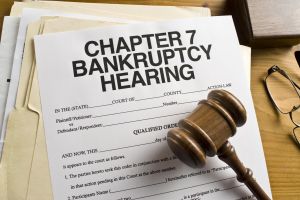
Source: Kirby Hamilton / Getty
Very often, bankruptcy is the last ultimate solution for many debtors who have unbearable debts. With the filing of a chapter 7 bankruptcy, you will get rid of your debts instantly upon discharge and you will be relieved from the harassing calls of your creditors.
Although bankruptcy has many undesirable consequences such as your bad credit record staying on your credit report for 7-10 years, with a little work, you can improve your credit even before these negative records fall off of your credit file. Here are five easy steps you can take to rebuild your credit.
Step 1: Get to know your current credit status
The first step to rebuilding your credit is to be clear on where you stand. Order your three free credit reports from the three national credit bureaus: TransUnion, Equifax, and Experian. You can order these reports online, it simple and secure.
Print each report and review them closely. Review and understand the information listed in your credit reports and highlight any negative records or inaccuracies that are damaging your credit score.
Step 2: Check the expiration dates
By law, your bad credit record will remain in your credit report for 7 to 10 years, but the exact expiration date might be different among these 3 reports. Your bad payment record will remain on your credit report even if you pay them off or they are discharged in bankruptcy.
Look up the exact date of each negative item on your credit reports including judgments, liens, charge offs, late payments, bankruptcy filings, and collection records. You will likely see a major improvement in your credit score when these records expire. So, stay on top of this process.
Step 3: Request For Correct On Any Inaccurate Records
If you find inaccurate records, fraudulent accounts, or records that should have expired on you credit reports, you have the right to send a separate dispute letter to each of the credit bureaus to correct your Equifax, Experian, and TransUnion records. The bureaus will initiate an investigation to see whether your requests are valid and if so, they will correct the inaccuracy in your credit report. This process will take up to 30 days.
Just one note, don’t try to dispute any of the positive information listed in your credit reports and it is a waste of time to attempt to dispute these records. Disputing positive information may actually harm your credit scores.
Step 4: Start to create good credits
Since there is no way to remove an accurate negative item from your credit report, the best way to improve your credit score is to add good credits and work on building up your credit from there. You can easy do this by opening up a new credit card from banks that offer a credit card plan designed specially to help people rebuild their credit after bankruptcy.
Use your new credit card responsibly and make the monthly payments timely. Doing this, you are building a new history of good credit behavior on your credit report. Over time, you may want to open additional credit card accounts or obtain a loan to boost your credit score even higher. But, in all cases use credit responsibly.
Step 5: Monitor your progress
Subscribe to a credit card monitoring service and use it to track your credit score progress closely. Most charge you a monthly or annual fee. However, Credit Karma dot com is a free service. Your credit score should improve steadily as you continue to use credit responsibly and add new positive information to your credit reports.
Summary
Bankruptcy does not need to chain you to bad credit for the next seven to ten years, but you have to be proactive in order to recover and rebuild your credit.
* J Thomas Smith is host of “Sunday Morning Live” on KMJQ/Majic 102.1 (9-11 am). He is an attorney, author, keynote speaker and mental health consultant. Your comments are welcome: jtsmith@radio-one.com. Follow on Twitter @drjtsmith102.














